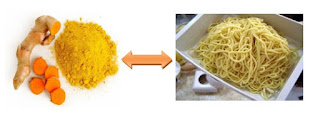Carbohydrate (English version)
Carbohydrates
are polyhydroxy aldehydes or polihidroksiketon and include the polymers formed
condensate. Name of carbohydrates used in these compounds, given the empirical
formula be CnH2nOn or approaching Cn
(H2O)n, namely carbon which undergo hydration. However,
this name is not appropriate because hydrate (H2O) which is attached
to the carbon cluster is not as actual hydrate, for example, can not be
separated or separate crystallized regardless of group.
In
nature, carbohydrates are the synthesis of CO2 and H2O
with the help of sunlight and green leaves (chlorophyll). The results of
photosynthesis is then polymerized into starch and compounds other great molecule into plant food
reserves. Organisms that can synthesize biomolecules for the purpose of his
life from inorganic materials (such as CO2 and H2O) are
called autotrophs organisms. While microorganisms in general, animals and
humans are only able to use the results of the synthesis of autotrophs organisms
for the purposes of his life called heterotroph organisms. Carbohydrates from
the main source of calories or macronutrient heterotroph organisms. Some of
them became the main ingredient of clothing (eg cotton fibers), Industry (hemp,
roselle), building materials (wood, bamboo) or fuel (firewood, litter). Besides
being a major source biokalori in foodstuffs, some types of carbohydrates and
derivatives (derivatives) plays an important role in food technology eg gum
(arabic, karaya, guar) as thickeners or CMC (carboxymethycellulose) as a
stabilizer and many more as a sweetener (sucrose, glucose, fructose).
Source:
Sudarmadji Slamet, Bambang Haryono, dan Suhardi. 2007.
Analisa Bahan Makanan Pertanian.
Liberty. Yogyakarta.



Comments
Post a Comment